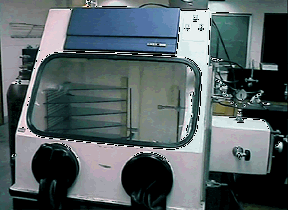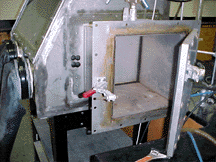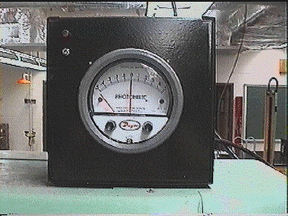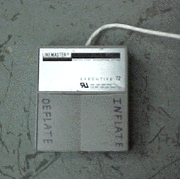
|
Safety Emporium for all your lab and safety needs
 The Glassware Gallery
The Glassware Gallery
Glove Boxes
Introduction
An inert atmosphere glovebox (also referred to as a "dry box") is a piece of equipment used for the manipulation of air and water sensitive materials. It consists of a large box or chamber with at least one window. The window has two or more ports for a pair of arm-length gloves, permitting the manipulation of equipment or chemicals inside. You will sometimes see double-length or even triple-length gloveboxes in industry. Some even have pairs of gloves on both sides of the box.
Below is a modern Vacuum Atmospheres glovebox and below that is an older and lower-tech (lower cost) example:


The glovebox atmosphere
The atmosphere inside the glovebox is usually nitrogen, argon or helium. Nitrogen is the cheapest alternative, but sometimes the materials under study are reactive with nitrogen. In addition, nitrogen-filled boxes are more prone to static problems than argon or helium, making weighing difficult without an anti-static device.
Gloveboxes are sometimes equipped with electronic sensors to monitor oxygen and water content. In addition, a variety of (cheaper) chemical means are also used. For example, dialkyl zinc reagents react vigorously with water to make dense fumes of ZnO even at very low oxygen or water concentrations. If you open your diethyl zinc bottle and it fumes, your atmosphere is less than perfect (Note: if you did this outside the box, you would have a bright blue flame!).
Older and cheaper varieties of gloveboxes do not come equipped with fancy recirculators etc., but can still be useful. The easiest way to purify an atmosphere in such a box is to open a purge valve on the box (vented to a fume hood) and purge the box with a high purity inert gas. It is necessary to purge the box on a daily basis as oxygen can diffuse directly through the gloves even under positive pressure, especially if there any leaks or pinholes.
Key features of a glovebox
The Antechamber 

A glovebox is not much good if you don't have a way of getting your materials in and out. If you look at the pictures above, you'll notice that there is a sealed chamber on the right side of the glovebox. This chamber is called the antechamber (or "port" by some) and it has two doors -- one that can be opened only from the inside of the box and one that can be opened only from the outside. As you can see in the photo on the left, the outer door to the antechamber is open, ready for glassware to be placed inside. See below to see how the antechamber is used.
The antechamber can be evacuated with a pump or filled with nitrogen gas. Never have both doors open at the same time!!
The Photohelic Gauge 

The photohelic gauge controls the upper and lower pressure limits in a glovebox. Modern gloveboxes use a solid state controller or touch screen interface, but the function is the same. If the pressure in the box gets too high, the controller automatically opens a valve to the vacuum pump to relieve the excess pressure and prevent the gloves from blowing off. Likewise, if the pressure is too low, the controller fills the box with nitrogen. You can set these upper and lower limits by turning the two small knobs below the gauge. The two red needles on the gauge indicate the current settings and the black one (coincident with the lower setting in this photo) indicates the current pressure.
Having the glovebox at a negative pressure with respect to the atmosphere is a Bad Thing because air will be drawn into the box through any small pinholes or leaks. Therefore, one tends to operate a glovebox at a slight positive pressure (i.e. both the cutoffs should be to the left side of zero).
The Pedatrol 

The pedatrol is a foot pedal that allows one to manually adjust the pressure inside the glovebox. The high and low limits set on the photohelic gauge still apply, but you can use the pedatrol to open the box to the vacuum pump or the nitrogen supply to get the pressure to a comfortable working level.
Notice that the pedatrol is sort of like a two-button computer mouse. Pressing on the left side decreases the pressure in the box and pressing on the right side increases it. No, you can't press both sides at once!
The Gloves
The gloves are obviously an important component of the glovebox. The gloves on a glovebox are usually sized large so that anyone can get their hands in. This makes life a bit difficult for people with small hands, but one quickly learns how to deal with oversized gloves.
The biggest threat to the atmospheric integrity of the glovebox comes from pinholes and cuts in the gloves. The most common ways of damaging the gloves involve the use of razor blades, copper wire (sharp ends), syringe needles and scissors inside the box. If you do use any of these BE EXTREMELY CAREFUL!! Gloves are rather expensive and replacement is required if there are more than three or four pinholes on either glove (depending on size).
The Drytrain
On a research grade glovebox, the atmosphere is purified to less than 1 ppm H2O and less than 5 ppm O2 by circulating it through a catalyst bed (also called a "dry train"). The catalyst bed contains Q5 catalyst to remove oxygen as well as zeolites to remove water. After a period of use, the dry train is regenerated by isolating it from the box, exposing it to hydrogen gas and heating it. The adsorbed oxygen is converted into water and the water is easily removed in vacuo.
Using the glovebox
Bad Things

Storage vessels like these make bringing solvent into a glovebox easy.
There are several Bad Things that you want to avoid when using a glovebox:
- Bringing water or air into the box. All flasks brought in must be nitrogen-filled or evacuated. Make sure all empty containers are open when the antechamber is being pumped down. Remember to open packets containing syringes etc. before bringing them in.
- Pulling solvents into the pump. When you pump in a flask containing a volatile solvent such as diethyl ether, the stopper will blow out unless it is properly secured (even an "evacuated" flask of ether has about 400 torr of vapor pressure). DO NOT rely on simple plastic clips to retain a stopper. Ask your instructor for the proper way to deal with this. If you suck solvent into the pump you must change the pump oil immediately.
- Sucking the gloves into the box. If you leave the inner antechamber door open and evacuate the antechamber, you evacuate the inside of the box. The gloves will suck in, balloon up and then burst. Bad News.
- Having both the inner and outer door to the antechamber open at the same time.
- Putting holes in the gloves (see above under Gloves).
- For "real" boxes that have a catalyst drytrain: the drytrain catalyst can be irreversibly damaged by thiols, amines, phosphines, halides etc. If you need to use any of these materials, you must first shut off the drytrain. Afterwards, you will need to purge the box atmosphere before re-opening the drytrain.
To bring something into the glovebox:
- Close the antechamber valve leading to the vacuum pump.
- Slowly open the antechamber nitrogen valve until the antechamber is at atmospheric pressure then close the valve.
- Double check that the inner door is not open!
- Open the outer door, place your stuff inside and close the outer door.
- Double check that the nitrogen valve is closed, then slowly open the antechamber vacuum valve.
- After 10 minutes of pumping, close the antechamber pump valve and partially backfill the antechamber with nitrogen. Then evacuate the antechamber again.
- Repeat the above process after an additional 5 minute interval (why??)
- After another 5 minutes, close the antechamber pump valve, then backfill the antechamber to atmospheric pressure with nitrogen. Close the nitrogen valve.
- Open the inner door and bring in your stuff.
To bring something out of the glovebox:
- Follow the above instructions to get the antechamber under nitrogen.
- Put your stuff in the antechamber and close the inner door.
- Double check that the inner door is closed and that both antechamber valves are closed.
- Open the outer door, remove your stuff and close the outer door.
- Double check that the nitrogen valve is closed, then slowly open the antechamber vacuum valve.
General Notes

If you use a rotary evaporator in your glovebox, be sure to use bump traps like these.
- If you aren't sure if the antechamber is under air or nitrogen, remember this simple rule:
When in doubt, pump it out
Of course, before pumping down the antechamber, always open the outer door (carefully) to make sure there are not any materials in there such as open bottles of solvent.
- If you are going to open a bottle of deuterated NMR solvent, make sure that the box is free from "regular" solvent vapors. Otherwise, you'll contaminate the NMR solvent and have large spurious contaminant peaks in your spectra.
- As with any piece of equipment, when you are done with the box, CLEAN IT UP. Leave it in equal or better condition compared to when you started your work.
- If the gloves are dripping with sweat when you are done, please be courteous and wipe them off!
Further Reading
- A Glovebox Design Checklist by Arthur Frigo of Argonne National Laboratory, hosted by the American Glovebox Society.
- List of glovebox vendors at Lab Manager.